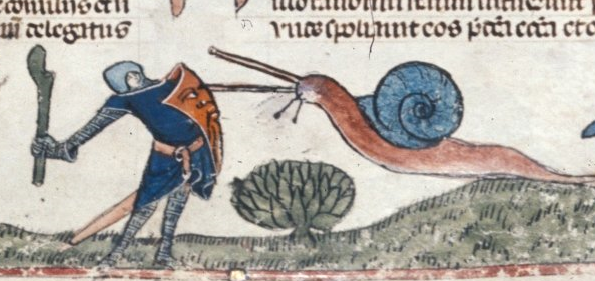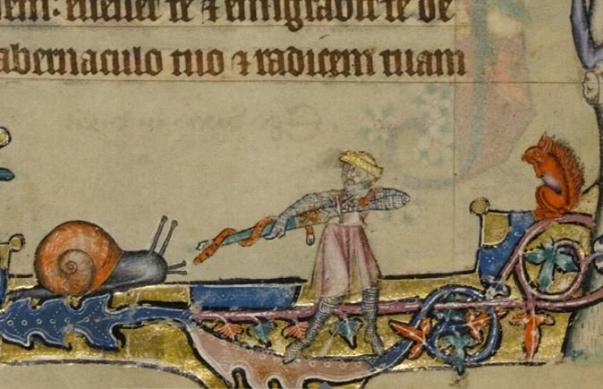The snail may leave a trail of slime behind him, but a little slime will do a man no harm… whilst if you dance with dragons, you must expect to burn.
- George R. R. Martin, The Mystery Knight
As any Game of Thrones fan knows, being a knight has its downsides. It isn’t all power, glory, advantageous marriages and gifts ranging from castles to bags of gold.
Sometimes you have to fight a truly formidable opponent.
We’re not talking about bunnies here, though there’s plenty of documentation to suggest medieval rabbits were tough customers.
As Vox Almanac’s Phil Edwards explains, above, the many snails littering the margins of 13th-century manuscripts were also fearsome foes.
Boars, lions, and bears we can understand, but … snails? Why?
Theories abound.

Detail from Brunetto Latini’s Li Livres dou Tresor
Edwards favors the one in medievalist Lilian M. C. Randall’s 1962 essay “The Snail in Gothic Marginal Warfare.”
Randall, who found some 70 instances of man-on-snail combat in 29 manuscripts dating from the late 1200s to early 1300s, believed that the tiny mollusks were stand ins for the Germanic Lombards who invaded Italy in the 8th century.
After Charlemagne trounced the Lombards in 772, declaring himself King of Lombardy, the vanquished turned to usury and pawnbroking, earning the enmity of the rest of the populace, even those who required their services.
Their profession conferred power of a sort, the kind that tends to get one labelled cowardly, greedy, malicious … and easy to put down.
Which rather begs the question why the knights going toe-to- …uh, facing off against them in the margins of these illuminated manuscripts look so damn intimidated.
(Conversely why was Rex Harrison’s Dr. Dolittle so unafraid of the Giant Pink Sea Snail?)

Detail from from MS. Royal 10 IV E (aka the Smithfield Decretals)
Let us remember that the doodles in medieval marginalia are editorial cartoons wrapped in enigmas, much as today’s memes would seem, 800 years from now. Whatever point—or joke—the scribe was making, it’s been obscured by the mists of time.
And these things have a way of evolving. The snail vs. knight motif disappeared in the 14th-century, only to resurface toward the end of the 15th, when any existing significance would very likely have been tailored to fit the times.

Detail from The Macclesfield Psalter
Other theories that scholars, art historians, bloggers, and armchair medievalists have floated with regard to the symbolism of these rough and ready snails haunting the margins:
The Resurrection
The high clergy, shrinking from problems of the church
The slowness of time
The insulation of the ruling class
The aristocracy’s oppression of the poor
A critique of social climbers
Female sexuality (isn’t everything?)
Virtuous humility, as opposed to knightly pride
The snail’s reign of terror in the garden (not so symbolic, perhaps…)
A practical-minded Reddit commenter offers the following commentary:
I like to imagine a monk drawing out his fantastical daydreams, the snail being his nemesis, leaving unsightly trails across the page and him building up in his head this great victory wherein he vanquishes them forever, never again to be plagued by the beastly buggers while creating his masterpieces.
Readers, any other ideas?

Detail from The Gorleston Psalter
Related Content:
Ayun Halliday is an author, illustrator, theater maker and Chief Primatologist of the East Village Inky zine. Join her in New York City May 13 for the next installment of her book-based variety show, Necromancers of the Public Domain. Follow her @AyunHalliday


Thank you, Ayun!
This article as added the exact amount of humility to my Friday—just what I needed.
Ms. Halliday may be interested to learn that “to beg the question” does not mean, in educated discourse, “to invite or provoke a question.” Begging the question, a loan translation of the Latin “petitio principii,” is “the logical fallacy of undue assumption of axioms.” A “principium” is “a truth that can be known in itself, [and[ ‘[p]etitio principii’ is, therefore, committed when a proposition, which requires proof, is assumed without proof.” In the wide sense, the term means “the assumption in some form of the very proposition to be proved, as a premise from which to deduce it.”
stick it, craig.
Stick it, Michael.
Ayun —
A very interesting read. Maybe waterborne diseases — e.g. Schistosomiasis — transmitted by snails in water helps to explain the need to battle snails?
The Reddit comment sounds plausible(or at least fun to imagine) a cloistered up monk’s most dangerous nemesis well could be the plagues in the monastery’s garden.
Or “beating up the snail” was a common euphemism in their partner-less lives.
Little known fact: snails are dicks.
What about slugs?
Has anyone seen a slug in medieval art?
Pieter Bruegel has one in his drawing of the Sin Of Sloth 1557.
Maybe because it is a symbol of laziness ?
Sloth was a deadly sin and one that monks were particularly aware of. So yes.
Hello welcomes to Monrovia Liberia snail poturay farming group in voinjama city Lofa county Liberia. For more information please contact me on WhatsApp. +231555760345
Thanks
Well, I fell down a rabbit hole while doing a search on the Bayeux Tapestry and I landed in an AMAZING place! Knights fighting snails in the margins of medieval manuscripts. I feel a little bit like Alice just now.
(◦’⌣-◦)
I suspect it is crude and simple. It builds on 3 arguments:
1) Monks were men not less preoccupied with sex, boredom and bad jokes than the rest of us.
2) The word “cock” as an euphemism for penis seem to be attested back to the 1200’s, but at least by the 1400’s.
Refrence: https://www.etymonline.com/word/cock
3) Latin for snail is “Cochlea”. As if that was not enough to trgger the associations of young men learning latin cooped up in a monastery, a snail shell is a “cochlea testa”. As a potential bonus, the last syllable “lea” may be similar enough to Old English “lēah”, which means meadow, pastureland or fertile forest clearing, that it may have had the obvious associations to a woman’s bush. (Indeed the words “fitte/fete” for “pastureland” and “vulva” are still the same in my related maternal language: Norwegian.)
Thus, for horny young monks speaking Medieval English, pronouncing “Cochlea” may have been like having a bunch of teenagers saying “Dickbush”. Add the phusical nature of snails as vaguely sausage-shaped beings slithering in and out of narrow shell openings and leaving a trail of mucus and, well, the results would be predictable.
The church had (and have) a lot of ideas around fighting sexual urges, so if pressed, a young scribe could also take the high road and say that he was depicting the constant and frequently unsuccessful and humbling daily struggle against the sexual nature of man. It may even sometimes be true.
OK, there’s also the daily struggle of the monks against that despoiler of lettuce, that killer of gardening abundance, the SNAIL! But I do like the “cochlea” explanation, and Latin was the lingua… wait… Latina of the church after all.